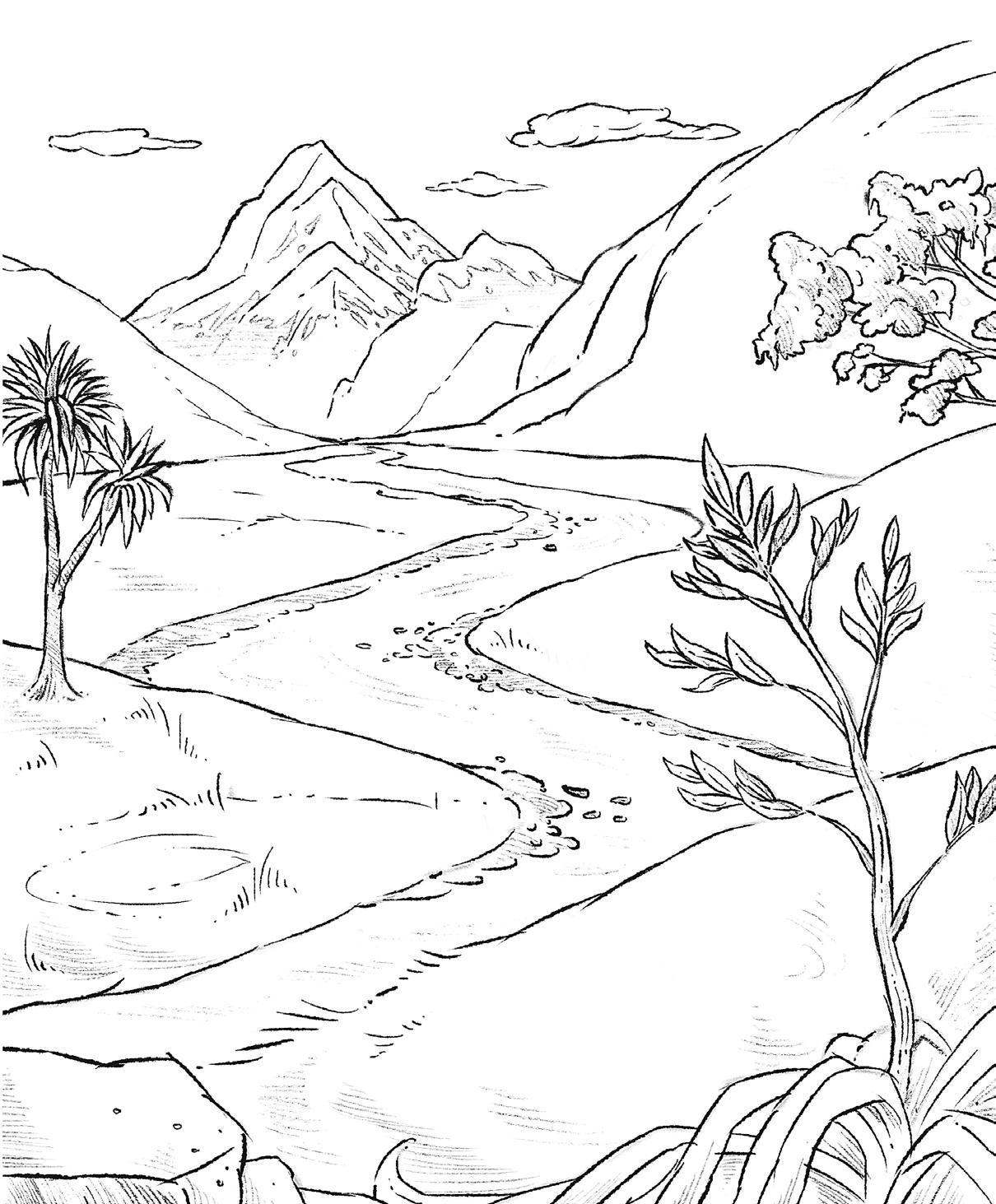

Hide and seek
Lookout 1 by Tony de LautourTony was born in Melbourne and has lived in Christchurch most of his life. His art is quirky and full of dark humour.
This painting might look like a typical New Zealand landscape but there are exotic creatures running wild and hiding in the grass and trees that don’t belong there.
Can you spot them? How many creatures can you count?

Imposters
Colour this New Zealand scene and add some creatures you would not expect to find there.
Are your creatures friendly or scary?

Painted urn
Attic volute crater, 1779, depicting scenes from the odyssey of Captain Cook by Marian Maguire
Marian was born in Christchurch and studied printmaking in New Zealand and America. In this print of a Grecian-style urn, she has mixed drawings of Greek, Māori and Pākehā people and objects to tell a story involving the British explorer Captain James Cook and the Tahitian priest and navigator Tupaia.

What else can you see?
Your own legend
Draw scenes from a story that you have read on this Grecian-style urn. Place different parts of the story on different levels.
Show your picture to a friend. Can they work out what is happening in the story?

Layered Painting
Back bone by Shane Cotton
Shane was born in Upper Hutt and belongs to the Ngāpuhi and Ngāti Hine iwi. Look closely at his painting. Can you see these layers:

□ smooth, blurred grey paint, which looks like sky
□ rugged, textured black and white paint, which looks like rock
□ finely-painted, floating red, black and white lines and shapes, which look like symbols
□ red spray paint, which looks like graffiti.
Can you see a falling manu or bird? Why do you think Shane called this painting ‘Back bone’?
Cliff face
Look at the pattern and texture in this rocky surface. Use your imagination to see a picture in it.
Draw onto the rock using layers of different materials. You could try chalk, crayon, pen, pencil or paint.



Spiralling Shapes
Camowhaiwhai by Andrew McLeodAndrew is from Rotorua and now lives in Auckland. He made this painting in the style of a colour-by-numbers picture.
He used four different colours. What do the colours remind you of?

Colour-by-numbers
The shapes in this picture are different types of koru or spiral motifs, like those found in kōwhaiwhai patterns. In Māori art, koru can represent new life or growth. Colour the numbered shapes using four colours. Colour the key below first to help you remember which colours to use for which number.

1. 2. 3. 4.
Add some more koru to this pattern. Label your koru with numbers one to four and colour them in following your key.
My art collection #11
OMG, what are they saying? by John Walsh


A Comet Cloth

Ngatu (Tongan bark cloth)

Ngatu is the word for bark cloth in Tonga. It is made from the bark of the paper mulberry tree. A ngatu is a valuable treasure that is used at special occasions, such as weddings and funerals, and handed down from generation to generation. This old and precious ngatu records an important historical event – the appearance of Halley’s Comet over Pacific skies in 1910. Can you spot these shapes? □ fetu‘u | star
To make ngatu, first the bark of the paper mulberry tree is soaked in water, then beaten to stretch and flatten it. Lots of beaten pieces are hung up to dry then joined together with tapioca or cassava glue. To decorate the cloth, kupesi pattern boards are placed underneath it and coloured dye is rubbed over it, leaving an impression of the pattern on the cloth. The patterns are outlined again to make sure the dye doesn’t fade.
Rub, rub, rub
Patterns on a ngatu are made by rubbing over a pattern board. Use textured objects or your own pattern board to make a picture. You will also need crayons or pencils. You could try using coins, leaves, keys, wood grain and woven fabric, or you could make your own pattern board using matchsticks or toothpicks glued in a pattern onto cardboard.
Place your objects or pattern board under this page. Rub over the page with the side of a crayon or pencil to reveal the texture of the object beneath.


Mesmerising
Natural
byReuben Paterson
Reuben’s family are Ngāi Tūhoe, Ngāti Rangitihi and Scottish, and he lives in Auckland.
Look at the large black whetū or star in the middle of this painting. Reuben made this picture using ngā porotaka or circles and lots of diagonal straight lines in different directions. It is hard to see here but he also used glitter and diamond dust to make the surface of the painting sparkle.
Every alternate shape is painted pango or black and mā or white. The lines and colours make some parts of the drawing look as if they are poking in and other parts poking out. How do your eyes feel when you look at it?
The style of this painting is similar to op art. Op art includes optical illusions or tricks for your eyes. Op art patterns are often black and white and can make the page look as if it’s moving – either poking in or out, waving or flashing.

Zigzag
Complete this picture to make a dazzling pattern. Draw diagonal straight lines in different directions crossing over each other.

Use a ruler to keep your lines straight. Which two colours will you use?
You could add a fine layer of glitter to your picture to make it sparkle!
